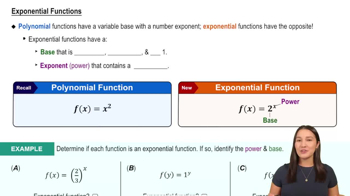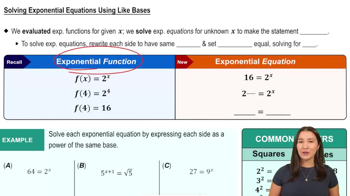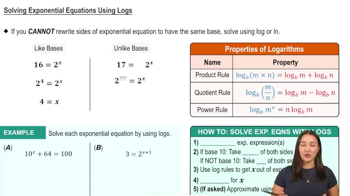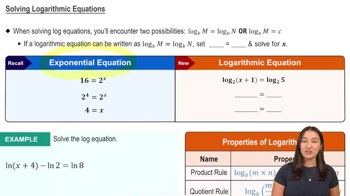Table of contents
- 0. Functions7h 52m
- Introduction to Functions16m
- Piecewise Functions10m
- Properties of Functions9m
- Common Functions1h 8m
- Transformations5m
- Combining Functions27m
- Exponent rules32m
- Exponential Functions28m
- Logarithmic Functions24m
- Properties of Logarithms34m
- Exponential & Logarithmic Equations35m
- Introduction to Trigonometric Functions38m
- Graphs of Trigonometric Functions44m
- Trigonometric Identities47m
- Inverse Trigonometric Functions48m
- 1. Limits and Continuity2h 2m
- 2. Intro to Derivatives1h 33m
- 3. Techniques of Differentiation3h 18m
- 4. Applications of Derivatives2h 38m
- 5. Graphical Applications of Derivatives6h 2m
- 6. Derivatives of Inverse, Exponential, & Logarithmic Functions2h 37m
- 7. Antiderivatives & Indefinite Integrals1h 26m
- 8. Definite Integrals4h 44m
- 9. Graphical Applications of Integrals2h 27m
- 10. Physics Applications of Integrals 2h 22m
0. Functions
Exponential & Logarithmic Equations
Problem 87f
Textbook Question
Determine whether the following statements are true and give an explanation or counterexample.
(4x+1)ln x = xln(4x+1)
 Verified step by step guidance
Verified step by step guidance1
Step 1: Start by examining the given equation: \((4x+1)^{\ln x} = x^{\ln(4x+1)}\). We need to determine if this equation holds true for all values of \(x\) or if there is a counterexample.
Step 2: Consider taking the natural logarithm of both sides of the equation to simplify the exponents. This gives us \(\ln((4x+1)^{\ln x}) = \ln(x^{\ln(4x+1)})\).
Step 3: Apply the logarithmic identity \(\ln(a^b) = b \cdot \ln a\) to both sides. This results in \(\ln x \cdot \ln(4x+1) = \ln(4x+1) \cdot \ln x\).
Step 4: Notice that both sides of the equation are identical, \(\ln x \cdot \ln(4x+1) = \ln x \cdot \ln(4x+1)\), which suggests that the original equation is true for all \(x > 0\) where the logarithms are defined.
Step 5: Conclude that the statement is true for all \(x > 0\) where both sides of the equation are defined, as the simplification shows both sides are equal.
 Verified video answer for a similar problem:
Verified video answer for a similar problem:This video solution was recommended by our tutors as helpful for the problem above
Video duration:
2mPlay a video:
Was this helpful?
Key Concepts
Here are the essential concepts you must grasp in order to answer the question correctly.
Logarithmic Properties
Understanding the properties of logarithms is essential for manipulating expressions involving logarithmic functions. Key properties include the product, quotient, and power rules, which allow us to simplify or transform logarithmic equations. For instance, the power rule states that ln(a^b) = b * ln(a), which can be useful in analyzing the given equation.
Recommended video:

Change of Base Property
Exponential Functions
Exponential functions are functions of the form f(x) = a^x, where 'a' is a constant. They exhibit unique properties, such as rapid growth or decay, depending on the base. In the context of the given equation, recognizing how exponential functions relate to logarithmic functions is crucial for determining the validity of the statement.
Recommended video:

Exponential Functions
Equivalence of Functions
To determine if two expressions are equivalent, one must analyze their behavior across their domains. This involves checking if they yield the same output for all input values. In the case of the given equation, evaluating both sides for specific values of 'x' can help establish whether the statement holds true or if a counterexample exists.
Recommended video:

Properties of Functions

 4:46m
4:46mWatch next
Master Solving Exponential Equations Using Like Bases with a bite sized video explanation from Callie
Start learningRelated Videos
Related Practice




